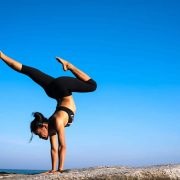Two-Week Food Challenge – Part 2
Whether you completed the challenge to drop some body fat or to improve your strength to weight ratios as an athlete, congratulations on finishing your 14-day food challenge! As you can see (and feel), the influence of food on your body is absolutely incredible.
The key to eliminating negative symptoms in the future is being aware of what you are consuming (solid foods and liquids), how much you are consuming, when you are consuming them and how your body responds to the food & liquid 20-30 minutes after eating.
Here is where I will inform you of the highly technical component of what you did over the last 14 days: you have stabilized your blood sugar levels. Think about it, you have consumed foods and fluids that don’t increase your blood sugar levels quickly (along with a burst of insulin) and as a result your body has become less dependent on simple sugars (this is also known as a low glycemic meal strategy). It is that simple!
Notice that there wasn’t anything to purchase (unless you found that you weren’t consuming enough high quality fish or protein); instead the food recommendations were based on raw fruits & vegetables and clean sources of protein – real food that you can easily find at your local grocery store or farmers market.
To help you keep your momentum going, I want you to complete the following steps:
Step 1: Re-take your Symptom Survey & Create Your Customized Eating Plan
Compare your results between your two surveys, has any of your negative symptoms improved? If so, you now realize that you have created an eating plan (NOT A DIET) that will directly reduce and eventually eliminate your frustrations or discomforts associated with food. Compare your results of retaking your Symptom Survey and see which category you fall into:
Result #1: Your symptoms have decreased by 70% or Less In this situation, you know that the food selection & quality is correct, you just need to continue with your current way of eating.
Keep in mind that your symptoms are a residual result of your eating & exercise habits over many years; though it will not require the same amount of time, you will need to stay consistent (with selection, consistency, quantity and quality) to replenish and re-balance your body with essential vitamins, minerals and protein to eliminate any deficiencies.
Solution #1: Don’t add any new foods to your meal plans other than what you have been eating over the last 14 days and complete the 14 day Clean Eating Challenge again. If you are feeling “hungry” at any time, continue to add more volume when you snack or eat a complete meal along with food items that satisfy appetite effectively (avocados, lean protein sources, extra virgin olive oil)
Result #2: Your symptoms have decreased by 80-90% In this situation, you have provided your body the calories (carbohydrates, protein & fat), along with vitamins & minerals it needed to address & eliminate your symptoms.
Solution #2: Take the food items & quantity that you have been consuming and continue to consume them like you were during the 14 day challenge. If you want to add a new item, only add one (1) item per week and run it through your mental clarity & energy level assessment: If your mental clarity & energy levels are good – keep the item in your weekly meals & snacks If your mental clarity & energy are not good – drop the item from your weekly meals & snacks
Continue this process indefinitely until you are satisfied with the amount of items you have verified interacts with your body in a healthy and positive way. Ironically, you may find that you have certain sensitivities that are outside the mainstream categories such as: carbohydrate intolerant, lactose intolerant, etc.
It has been my experience with clients over the years that the combinations of certain food items create negative symptoms, not a single item. It is for this reason that you will want to add only one item at a time to your existing list of food items that you have verified don’t create the negative effects on your mental clarity and energy levels. This is the foundation to your customized nutrition & hydration program!
Step #2: Re-Capture your Body Measurements
In my world, I live in a world of zero and ones – you are either making progress towards your goals or you are not.
If you are on track, we want to know what is contributing to this success: exercise, food, etc. However, if you are not achieving your goals, we want to know what is causing the goals to not be achieved. Notice that I don’t mention the word fail – you are not failing, you are simply not achieving your goals and we will determine what the cause is.
Your body measurements will help you see how your body is dropping body fat (adipose tissue) and building lean muscle by body part. This information is invaluable because it provides you immediate feedback into how your body is adapting to both food (quality and quantity) & exercise (intensity, duration and frequency).
Set your calendar up to re-capture your body measurements every six (6) weeks so that you don’t let too much time get past you to determine if your nutrition and exercise efforts are producing the results you desire.
Step #3: Make Clean Shopping a Priority
The same way that you initially went through and “purged your cabinets and refrigerator”, it is time to set your weekly personal calendar up so that you are going shopping for real food every three days.
It has been my experience with clients that the lack of time to purchase, clean, prep and pack fresh fruits, vegetables and lean protein sources is the number one reason why people default back to fast food, canned and packaged food items (all of which are loaded in sugar, salt and numerous unhealthy ingredients).
By shopping every third day, you will eliminate throwing away spoiled fruits; vegetables and protein along with ensure that you have plenty of high quality food readily available.
Step #4: Consume Real Food Smoothies
Throughout the 14 Day Clean Eating Challenge, one of the immediate sensations you will feel is that you are eating frequently (every 2 hours), but yet you are still hungry. The reason for this is associated with the fact that fruits and vegetables don’t contain very little to no protein and fat. Ironically, protein and fat are the only two elements that satisfy your hunger levels.
To help satisfy & manage your appetite on a daily basis, mix up this simple smoothie recipe in the morning and make enough to fill up two to three more glasses so that you can consume them as your mid morning and mid afternoon snacks.
When you consume your calories in a liquid format, your body absorbs the vitamins, minerals and calories much quicker; because of this, you will notice an improvement in both your energy levels and mental clarity throughout your day. Mix up and enjoy!
Coach Robb’s Good Morning Chocolate Necessary Ingredients: ½ Cup of Greek Full Fat Yogurt ¼ Cup of Organic Whole Milk 1 Scoop of Nutritionally Green’s Chocolate Premium Muscle Builder (appetite suppressant) 1 Large, ripe, organic banana
How to Prepare: Step 1: combine and puree all ingredients into the blender
Optional Supplemental Support: Complete Endurance Formula (high potency essential fatty acids) Complete Multi-Vitamin (enzyme & amino acid formulation)
Step #5: Exercise Correctly
When it comes to exercise, ironically most individuals exercise too hard, too long and too often which undermines the progress they are striving to achieve. Let’s briefly look at each variable:
Exercising too hard: training with a heart rate monitor will ensure that you are using the correct mixture of fat, stored sugar & protein for energy based on your personalized heart rate training zones. Please email me if you don’t know your personalized heart rate training zones and I will send you an assessment program along with a copy of my Coach Robb Heart Rate Training Zones Spreadsheet.
Exercising too long: there is a fine line between exercise serving as a tool to reduce stress and becoming another stress in your life (like financial, personal, professional, etc.). If your body is training too hard and too long, it will tap the parasympathetic system and release Cortisol, which is a fat magnet hormone. To ensure that you are not training too hard or long, keep a daily log of your resting heart rate and morning body weight. These two variables will provide you immediate feedback if your exercise is too much for your current state of fitness. Please email me directly for a FREE copy of my Coach Robb Body Analysis Spreadsheet.
Exercising too often: identical to exercising too long, there is a fine line between exercising as a stress reducer and another stress in your life. Depending on your personal goals and objectives, your training duration and frequency needs to be adjusted accordingly.
Step #6: Determine Your Current Fitness & Performance Levels
When it comes to determining “How fit you are”, you need to look at the combinations of your Body Measurements, Body Weight and complete a few fitness assessments. The goal is to calculate what I call Health or Performance Ratios (depending on your personal goals).
General Fitness/Weight Loss: For those of you looking to keep the weight off for your overall health, in the next newsletter I will outline a walking & strength program that I have used with thousands of clients to effectively keep those unwanted pounds off and tone up your entire body in 20-30 minutes a day.
Athletic Performance: For those of you looking to improve your athletic ability, I will be launching my new Anatomy of Speed series that will break down each component of performance and teach you what you can be doing to improve your performance while reducing your risk of injury and/or sickness (two negative side effects of training too hard, too long and too often).



